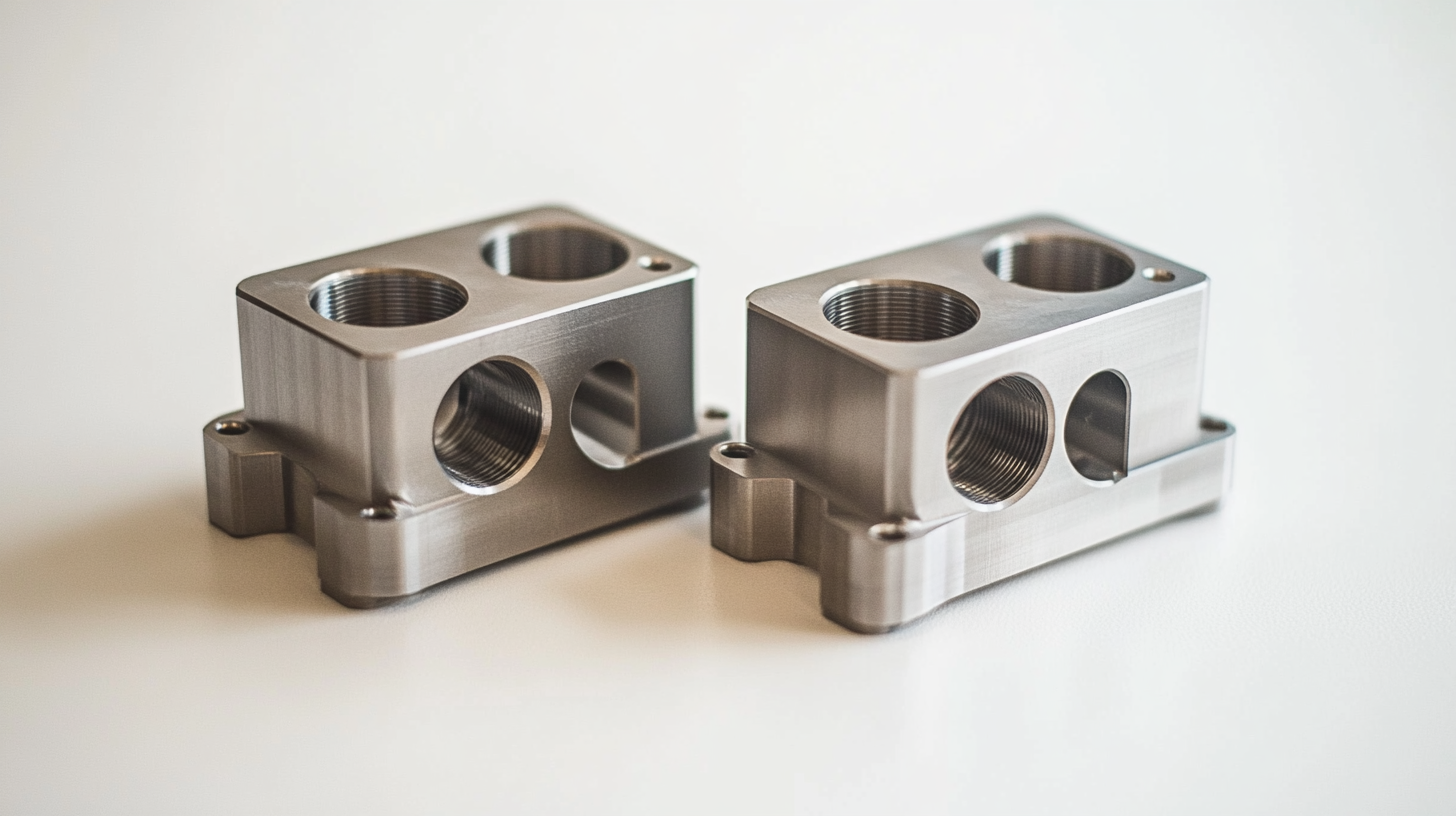 +86 180 0293 5268
+86 180 0293 5268






In the ever-evolving landscape of global manufacturing, the role of CNC milling parts has become increasingly pivotal. As industries strive for efficiency and precision, the global market for CNC machined components is projected to reach USD 103.52 billion by 2026, with a compound annual growth rate (CAGR) of 6.0% from 2021 to 2026, according to a report by Mordor Intelligence. This growth underscores the rising demand for high-quality, reliable components in sectors ranging from aerospace to automotive, where precision engineering is paramount.
Moreover, as companies seek to optimize their supply chains and reduce operational costs, the strategic sourcing of CNC milling parts has emerged as a key focus. A study by Statista highlights that around 75% of manufacturers are now exploring advanced procurement strategies to enhance their competitiveness. By leveraging cutting-edge CNC technology, businesses can unlock significant efficiencies, ensuring not only the consistency and reliability of their products but also their ability to meet the dynamic needs of the global market. Therefore, understanding the potential of CNC milling parts is essential for any organization aiming to secure a successful foothold in this competitive arena.

CNC (Computer Numerical Control) milling parts are becoming an increasingly vital component of global supply chains, especially as industries seek to enhance efficiency and responsiveness. The precision offered by CNC milling not only ensures high-quality components but also supports rapid prototyping and customization. As supply chains become more complex due to global interdependencies, CNC milling technology enables manufacturers to quickly adapt to market demands while maintaining rigorous quality standards.
Moreover, the benefits of CNC milling extend beyond mere production efficiency. The scalability of CNC systems allows companies, particularly small and midsize businesses, to tap into larger manufacturing capacities without requiring significant investment in workforce or machinery. As these businesses play a crucial role in supply chain resilience, they can leverage CNC milling to enhance their competitive edge. This is particularly important in the context of current economic uncertainties, where maintaining a robust supply chain is vital for sustainability and growth.
Furthermore, with the rise of next-gen technologies in various sectors, including precision machining, the integration of CNC milling into global supply chains is a strategic move. It streamlines operations, reducing lead times while fostering innovation. As industries continue to navigate challenges such as tariff uncertainties and supply chain shortages, CNC milling parts will be essential in optimizing procurement strategies and securing a competitive position in the global market.
When sourcing CNC milling components for global procurement, understanding the critical factors that influence decision-making can significantly enhance efficiency and cost-effectiveness. According to a report by the Global CNC Machining Market, the industry is projected to grow at a compound annual growth rate (CAGR) of 6.3% from 2022 to 2028. This growth stems from the increasing demand for precision-engineered products across sectors such as aerospace, automotive, and medical devices.
One key consideration is the material selection for CNC milling parts. Various materials such as aluminum, steel, and plastics offer different benefits in terms of durability, weight, and cost. A study published by TechNavio highlights that aluminum parts have seen a surge in use, particularly in the aerospace industry, due to their favorable strength-to-weight ratio. Additionally, it is crucial to assess suppliers based on their capabilities to work with advanced materials and their experience in delivering high-quality components that meet strict industry standards.
Another important factor is the geographical location of suppliers. The report from Deloitte emphasizes that sourcing from regions with established manufacturing hubs can lead to shorter lead times and reduced shipping costs. Furthermore, engaging in close collaboration with suppliers can enhance communication and ensure that any design modifications are swiftly addressed. As global procurement strategies continue to evolve, leveraging technology and data analytics for supplier evaluation will be key in securing optimal CNC milling components that align with business objectives.

In the realm of global procurement, effective quality control measures for CNC milling parts are paramount. With the increasing complexity of manufacturing processes, especially in Industry 4.0, businesses must leverage advanced technologies such as artificial intelligence and machine learning to enhance production efficiency and product quality. By implementing thermal error measurement systems using strategically placed temperature sensors on CNC machine tools, manufacturers can identify and rectify inaccuracies that can compromise part integrity.
Additionally, methodologies like Lean Six Sigma and DMAIC (Define, Measure, Analyze, Improve, Control) play a critical role in defect reduction during CNC milling operations. These systematic approaches not only streamline processes but also instill a culture of continuous improvement within organizations. By applying these quality control measures, businesses can ensure that the CNC milling parts procured from international suppliers meet stringent quality standards, ultimately contributing to successful global trade and customer satisfaction.
CNC milling parts have revolutionized the way businesses approach global procurement, offering remarkable cost-effectiveness that appeals to companies across various industries. One of the primary advantages of CNC milling is its ability to produce high-precision components with minimal waste. By optimizing material usage and streamlining manufacturing processes, companies can significantly reduce their production costs. This efficiency allows businesses to allocate resources more strategically, enhancing overall profitability.
Moreover, the scalability of CNC milling operations permits manufacturers to meet the demands of global markets without sacrificing quality. Whether small batch production or mass manufacturing, CNC machines deliver consistent results that ensure each part meets rigorous standards. This reliability is crucial for businesses looking to expand their reach internationally, as it fosters trust among partners and customers alike. By investing in CNC milling technology, companies not only lower their expenditure but also elevate their competitive edge in a crowded marketplace.
As global supply chains evolve, the demand for cost-effective manufacturing solutions remains at the forefront. CNC milling parts offer a practical answer to this challenge, allowing businesses to tap into international markets without the burdensome overhead typically associated with traditional manufacturing methods. The integration of advanced CNC technology not only streamlines production but also positions firms to respond swiftly to market changes, ultimately driving long-term success in the global arena.
The global CNC machine market is poised for significant growth, projected to increase from $101.22 billion in 2025 to a staggering $195.59 billion by 2032, with a compound annual growth rate (CAGR) of 9.9%. This surge illustrates the escalating demand for precision manufacturing and automation technologies, fundamentally transforming procurement strategies across industries. As companies seek to optimize their supply chains, leveraging CNC milling parts offers an opportunity to enhance efficiency and reduce costs while maintaining high quality standards.
In 2023, the global machine tools production market was valued at $134.96 billion and is anticipated to reach $169.47 billion in the coming years. This growth trend is driven by advancements in machining technologies, especially in AI and robotics, which are set to revolutionize industrial manufacturing. As these technologies become increasingly integrated within CNC operations, organizations can expect improved manufacturing accuracy, speed, and scalability—critical components for successful global procurement initiatives.
Furthermore, barriers to investing in CNC automation are gradually diminishing as more enterprises recognize the long-term benefits of enhanced accuracy and reduced labor dependence. The CNC machining landscape is evolving rapidly; by Q2 2024, new trends and significant industry investments are expected to emerge, further pushing the boundaries of efficiency and innovation in procurement strategies. Adapting to these changes will be essential for organizations aiming to remain competitive in an increasingly digitized world.

